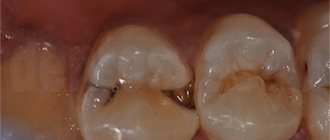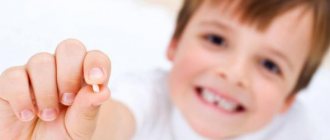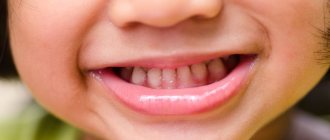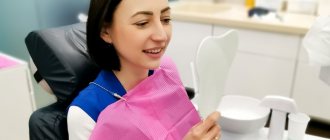Possible causes of gum inflammation
Quite often, parents have to deal with the problem of gum inflammation in children. When a child’s gums are noticeably swollen, red, and even bleeding, which affects his well-being and behavior, parents should imagine the possible causes of this condition in order to clearly act in such a situation.
The child tore his gum photo
Swollen gums in a child can be caused by the following factors:
- eruption of baby or permanent teeth - this usually occurs in 5-6 month old children and is characterized by noticeable swelling of the gums;
- Caries is the most common dental disease, which occurs as a result of unscrupulous cleaning, as well as a high content of carbohydrates in a child’s diet. At first, parents may not notice white spots on the teeth, but as the disease progresses, the infection penetrates into the deep layers of tissue and may manifest itself as swelling of the gums above the affected tooth;
- inflammation of the gums can cause gingivitis , in which the gums are very susceptible to injury and can bleed even during brushing;
- wounds, scratches, bleeding, swelling, redness of the gums - a common condition if a child’s gums are ripped off;
- inflammation after a tooth extraction procedure. In this case, gum swelling will be noticeable for several days after the visit to the dentist;
- lack of vitamin C, which causes looseness and inflammation of the gums.
Dental injuries in children. First aid.
Dental injuries in children. First aid.
Injuries and damage to teeth are very common in childhood. In the primary dentition, injuries occur in children from 2-3 years of age; this period is associated with the beginning of the development of coordination and the first attempts at independent movement and exploration of space; in the mixed and permanent dentition, the peak of injuries occurs at 8-12 years of age (in most cases, injuries recorded in boys at this age), the predominant causes of injuries at this age are falls, road traffic accidents and active sports. The upper and lower incisors are most often injured. The fate of the tooth and the amount of treatment in the future depend on the correctness and speed of actions of parents and relatives in the first minutes after the incident.
It is very important not to panic and try to assess the extent of the damage.
Complete dislocation (Avulsion)
If a complete rupture of the tooth ligaments occurs during an impact, it may completely leave the socket, and bleeding from the socket is also observed.
The situation is an emergency, requiring urgent contact with a dentist, you have 20 minutes to save the tooth. First of all, we look for the lost tooth, we try to hold only the crown part, without touching the root, if it is dirty, we quickly rinse it with water for a second, and the best option is to immediately return the tooth back into the socket on your own, with the convex side outward, focusing on the neighboring one tooth. To maintain the position, you need to clench your teeth or bite down on a gauze pad. Then go to the clinic to fix the damaged tooth (splinting). If it is impossible to straighten the tooth yourself, put it in milk and contact the clinic as soon as possible, minutes count.
After replantation and splinting, tetanus prevention and careful hygiene are necessary, as well as dynamic observation with X-ray control, and timely filling of the canal in order to avoid complications.
Dislocation, displacement
There is a change in tooth position and mobility. The gums may be damaged, ruptured, or bleed. A misaligned tooth can make it difficult to close your mouth.
Do not remove the tooth from its socket, touch it, or try to close the teeth together. Try to contact the clinic as soon as possible
If it is impossible to contact a doctor quickly, try to return the tooth to its place with light pressure, focusing on a symmetrical tooth, fix the position by closing your teeth, and seek help from the clinic as soon as possible.
In some cases, root canal treatment may be required (50% of cases)
Impacted dislocation (intrusion)
The tooth is motionless, but has become shorter in appearance or is not visible at all; swelling and bleeding from the gums may be observed
Contact the clinic immediately for reduction and splinting, or orthodontic rehabilitation may be prescribed.
In 90% of impacted dislocations, root canal treatment is required.
Fracture
A fragment of the crown of the tooth is missing.
Try to find the fragments and put them in a saline solution or milk, the dentist will fix them back. If the fragments are lost, try to get an appointment with a dentist during the day or the next day to have a composite restoration performed. If the pulp is exposed, it is not always necessary to depulp the tooth; direct coating with a therapeutic dental material based on MTA can be performed. In this case, dynamic monitoring is necessary every 3-6-12 months
In many cases, such consequences can be avoided; take care of protection for your children during outdoor activities, roller skating, scootering, and also playing sports - protective helmets, sports mouth guards.
Symptoms associated with gum damage
Regardless of the causes of gum damage, it becomes inflamed and is accompanied by the following conditions:
- swelling and change in shade (from bright pink to bright red);
- the presence of pain in the gums. The child experiences especially severe pain when eating, and if the food is hard, damage to the child’s gums may be aggravated by scratches, which may cause bleeding when pressed;
- unbearable itching, desire to scratch the gums, as a result of which the child puts toys in the mouth, which can also cause additional damage;
- general weakness and lethargy in behavior - the child spends a long time in the crib and refuses to play;
- lack of interest in food - while eating, the child experiences pain, so he refuses to eat, as a result of which he is in a hungry state, becomes even more weakened and pale;
- sleep disturbance - pain from damage to the gums can bother you even at night, which causes anxiety and irritation, the child becomes capricious.
Child broke gum photo
Causes of scratches on gums
The periodontal tissues and periosteum of the lower and upper jaw are in close contact with the mucous membrane of the gums. Mucosal tissue not only plays a protective function, but also serves as a conductor for metabolic reactions.
The tooth is nourished due to reliable blood supply and innervation in the gums, and any slightest damage will always result in a painful sensation. Thanks to this, the dentist can determine the location of the lesion and its parameters.
A scratch, be it a microcrack that is not visually visible, is a reason to seek specialized medical help. In the oral cavity (on the surface of the tongue, cheeks) there is a large amount of foreign microflora, which, if they get into the scratch itself, cause serious problems for the teeth and the body as a whole.
There are three reasons that cause gum damage:
- Mechanical factor - when the oral mucosa is damaged by hard food during eating (for example, when the gums are crushed with hard food: crackers, sweets, seeds) and during therapeutic measures (the gums are damaged during dental treatment - touching with a needle, drill, etc.). Mechanical damage (scratches) is more often caused by young children who carry unknown things to their mouths, gnaw or chew them.
- Chemical factor - when the mucous membrane is exposed to various chemical compounds (acids, alkalis).
- Thermal factor - ingestion of too hot food or water causes burns, and exposure to cold damages teeth.
One should take into account the fact that the mucous membrane becomes more susceptible when the human body’s immunity is reduced. Typically, this condition is caused by concomitant diseases: diabetes mellitus, HIV infection, benign and malignant neoplasms, sexually transmitted diseases.
In children
Since gum scratches more often occur in children who want to “taste” everything, their parents should carefully examine the oral cavity every day for the presence of such scratches. In children, the immune system is still weak and the protective mechanism in a small body may not work, and then a small scratch may be complicated by swelling and redness of the soft tissues around the lesion. Externally, the child will be restless due to soreness in the mouth.
The teenage generation has a high risk of bruises (street fights, football, bad falls). Vivid symptoms of damage include severe pain in the mouth, bleeding gums, a knocked out tooth, etc.
My child has broken his gum, what should I do?
Bruises usually heal quickly, but to prevent serious consequences, the child should still be seen by a doctor. The dentist will determine how badly the gums are damaged, treat the wound with antiseptic drugs, prescribe painkillers and rinsing solutions, and also recommend a special dental paste depending on the causes of the damage.
Miramistin solution
Preparations for rinsing, irrigation and oral baths:
- Chlorhexidine or Miramistin (in solution) to reduce inflammation and relieve bleeding;
- Kamistad (gel) to relieve pain and swelling during tooth eruption;
- Rotokan – solution for rinsing the mouth;
- Sangviritrin (alcohol solution) for applications;
- Solcoseryl Dental (ointment) for healing traumatic injuries.
Diagnosis of gum disease in children
A routine oral examination should be performed by a pediatric dentist every six months. And as necessary, if a small patient exhibits any deviations in the development of teeth or symptoms of disease of the oral mucosa. Since it is advisable to diagnose the inflammatory process at the earliest stage.
If redness, swelling and bleeding are detected, the cause of which is an excessive amount of soft plaque or food debris on the teeth, the dentist will make a diagnosis and prescribe procedures.
If a bacterial infection is suspected, a clinic specialist can take biomaterial from the inflamed areas of the gums for clinical tests. Based on the results of the analysis, the specialist prescribes a treatment plan and the date of the next appointment to ensure the final recovery of the little patient.
Consequences of injury and drug treatment
If a child’s gums are ripped off, the degree of injury is determined and treatment is prescribed:
- If the gums are inflamed and enlarged due to teething, a light massage can help the child. To do this, you can use a clean toy or gel with an anesthetic effect;
- in case of a tumor resulting from caries, depending on the clinical picture, the dentist removes or fills the damaged tooth and prescribes painkillers;
- for gingivitis, the dentist removes plaque, prescribes rinsing with antiseptics and treating the gums with anti-inflammatory agents;
- If there is a lack of vitamins, a balanced diet is prescribed.
Causes of gingivitis in children
Gingivitis in a child occurs under the influence of a number of factors. Their effect on growing, functionally immature gum tissue easily provokes the onset of the inflammatory process. In this case, the occurrence of gingivitis is often accompanied by a decrease in the body’s resistance (its defenses): weakened immunity, vitamin deficiency or hypovitaminosis, allergic or infectious diseases, disorders of the cardiovascular and endocrine systems, and the gastrointestinal tract. So, the factors that most often provoke gingivitis in children:
- Microbes. Almost 90% of cases of gingivitis are caused by the microbial flora of yellow plaque and tartar: the child hastily brushes his teeth due to reluctance or inability to do it more thoroughly. Microorganisms multiply quickly, and their metabolic products (toxins) contribute to the onset of the inflammatory process.
- Mechanical injury. Violations of the integrity of the oral mucosa, such as a cut, biting, scratch, burn, can cause an inflammatory process. We strongly recommend that you ensure that your child does not play with sharp objects and that their drinks and food are moderately warm.
- Biological agents. Infectious gingivitis is a common form of the disease. If your child has caries of primary or permanent teeth, the likelihood of developing gum disease increases many times over, which is why it is so important to treat carious teeth in a timely manner, or better yet, to take measures to prevent caries in children.
- Functional loads on the dental system. An incorrect bite in a child, impaired chewing function, insufficient length of the frenulum of the lips or tongue, bad habits (chewing food on one side, sluggish chewing) - all this leads to an uneven load on the child’s dental system and provokes the development of gingivitis.
- Prolonged tooth eruption. During the eruption of a permanent tooth, so-called “eruption gingivitis” may occur. The toothbrush causes pain to the child, so he spares the “overdue” tooth as much as possible during brushing. As a result, microbes accumulate, and this is a direct path to the development of inflammation.
Treatment with folk remedies
Treatment of gum injuries can also be done at home:
- rinsing with a decoction of chamomile, St. John's wort or calendula; you can also use a solution of baking soda or strongly brewed black tea;
- inflamed areas can be lubricated with honey or sea buckthorn oil.
If your child hurts his gums, don’t panic right away. You need to numb the area of the injury and go to the dental clinic for high-quality treatment of the damaged area and prescribe treatment.
Treatment of scratches and wounds on the gums
What to do if you cut your gum? If the scratch is without foci of inflammation and other signs of complications, then you can get by with treatment at home using traditional medicine and the use of local antiseptics. Treatment of with chlorhexidine or furatsilin when rinsing promotes healing of the scratch and will become a serious obstacle to infection.
Treatment activities will include:
- drug treatment;
- folk remedies for wound healing;
- surgical care.
Drug treatment of injured areas
Many dentists do not advise self-medication and delaying consultation, especially when the child has cut the gum. At the stage of specialized care, the doctor will examine the surface of the mucous membrane, the nature of the cut in the gums and tell you how to treat it.
For difficult-to-heal mouth ulcers, dentists use ointments with an antiseptic effect :
- gel "Metrogil denta";
- gel "Cholisal";
- "Levomekol" (antibacterial agent);
- medicinal paste “Parodontocide”;
Metrogyl and Cholisal
For deep cuts, in order to prevent purulent infection, antibiotics :
- penicillin antibiotics (Amoxiclav);
- tetracyclines (Doxycycline, Tetracycline);
- tyrothricins (Grammidin).
Along with antibiotic therapy, anti-inflammatory treatment is indicated, including the use of non-steroidal anti-inflammatory drugs :
- Ketorolac;
- Nimesulide;
- Diclofenac.
This therapy is aimed at reducing the inflammatory response and pain.
A frequent question: “What to do when you scratch your gum, it’s swollen and you have bad breath?” If the gums are scratched and have an unpleasant odor, this indicates an infection in the mouth. If there is a complication, then surgical intervention , the purpose of which is to release pus from the scratch and then treat it with local antibiotics.
Folk remedies for wound healing
If the patient has scratched his gums, but does not want to seek medical help, a solution may be to take folk remedies that will quickly eliminate signs of inflammation and relieve tissue swelling.
- Dried St. John's wort in combination with flax seeds and oak bark will cope with an infection in the mouth. By killing the infectious agent, this decoction will restore beneficial microflora. Use 1 time per day for a week.
- Pieces of propolis relieve the inflammatory reaction. Used in alcohol infusion or made in the form of plates, attached to the inflamed area of the gums for 30 minutes. Use daily until inflammation disappears.
- Compresses with calendula have a similar effect to propolis.
- Using a solution of potassium permanganate to relieve inflammation, 2 times a day, for a week (especially for pulpitis, stomatitis, gingivitis).
Treatment of scratches in a child
Since children are susceptible to infection, self-medication is not the right solution. If a child exhibits the corresponding symptoms of gum damage, you need to contact a dentist to decide on further treatment measures.
Even a microcrack in children is an indication for consultation. The doctor will examine you and tell you how to treat the inflamed scratch.
Prevention
- oral hygiene (make sure your baby brushes his teeth properly);
- balanced diet;
- rinsing your mouth every meal;
- preventive procedures (remineralization, fluoridation; fissure sealing);
- timely dental treatment;
- preventive examinations at the dentist 2 times a year.
Timely dental treatment for children and proper oral hygiene are the main weapons in the fight against caries and other diseases. Teach your child to take care of the health of their teeth and beautiful children's smiles will delight you every day!










